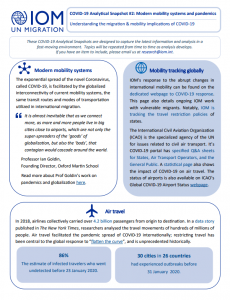Data are fundamental to evidence-based/informed policymaking, but what happens when data aren’t available, or at best, collection and availability are delayed significantly? That’s the threat that COVID-19 poses on data collection efforts and statistical operations around the world, including those that are important for long-term migration policy as well as those which will help policy makers respond quickly to the impact the pandemic is ravaging on vulnerable groups such as migrants.
In the face of social distancing and extended lockdowns, disruptions and delays in data collection and statistical operations are to be expected. But the longer these last, the more likely data collection efforts that have taken months or years to plan could be canceled altogether. That’s why it’s important in a rapidly changing environment to know how to adapt data collection and weigh the advantages and disadvantages of stopping or altering collection. At the same time, in the context of a pandemic such as COVID-19, it’s also critical to continue statistical operations as high-quality and timely data can inform policy makers’ decisions about how best to respond to the crises.
With the sheer volume of information and data on COVID-19 that is available now, it’s easy to get overwhelmed and filter what is relevant to the production of migration statistics. Whether you’re a researcher, national statistical officer, or census manager, here are 5 UN resources relevant to migration to help you adapt data collection efforts while aiming to not compromise data quality altogether, and continue a semblance of normal operations during this uncertain time.1
International resources
1. UNSD: Continuity of statistical operations
The UN Statistical Division’s COVID-19 response website provides national and international statistical organizations with one of the widest ranges of guidance, best practices, information, and tools to help adapt data collection and continue statistical operations. Sound migration policy hinges on the continued operations of these statistical organizations as they are key producers and disseminators of official migration statistics. Currently, statistical organizations are simultaneously facing the growing demand for data in response to the pandemic and reduced institutional capacity arising from telecommuting challenges, such as disruption to work flow and limited access to institutional systems and tools.
UNSD’s response website offers information on:
- Continuity of operations - Examples of guidance includes information on maintaining civil registration and vital statistics and using administrative data as an alternative to data collected in the field;
- Working remotely - Provides information on leveraging cloud computing, e-learning courses and virtual conferencing;
- Leveraging external data sources - Includes guidance on disaggregating COVID-19 data by sex, age groups and geographical areas;
- Open data - Provides resources on open data use and open data platforms.
- Additional resources – Provides COVID-19-related links from UN agencies, international organizations, regional economic and social commissions, and other partners in various sectors; and
- Sharing experiences – Includes information and links to social media, webinars and a hotline for the statistical community to challenges and lessons learnt related to COVID-19.
2. UNFPA: COVID-19 and Censuses
To advocate for the importance of the 2020 Census round and support governments’ contingency plans, UNFPA released a dashboard on the impact of COVID-19 on the Census and a Technical Brief on the Implications of COVID-19 on Census that provides information on:
- How countries are altering their census plans because of COVID-19;
- The availability of technical assistance through teleconferencing, webinars and other online platforms;
- Whether countries should consider changing to an e-census or use a registry-based census approach to estimating population; and
- The increasing importance of population data in the COVID-19 response and advice on not canceling the Census.
According to UNFPA, the 2020 Census round can provide countries with an opportunity to collect more migration-related data that are important for making decisions about national policy and development planning, to name a few. However, the advent of COVID-19 is pushing countries to decide on whether to postpone or cancel the 2020 Census round, as well as whether to divert some of the Census’ resources to fund emergency responses. Significant delays could compromise data quality and cancellations could rob countries of a wealth of data needed for a myriad of policy areas. According to UNFPA, with 150 countries scheduled to conduct the 2020 Census round this and next year, the “potential disruption of the 2020 census round could be significant.”
3. ILO: COVID-19 and labour market statistics
Data on COVID-19 and public health have understandably been the most collected and cited type of data during the pandemic, but there is increasing interest on collecting data on how COVID-19 is affecting the labour market. These types of data matter in the migration research and policy fields because migrants are part of the labour force, and in some sectors such as agriculture, construction, and the medical field, may be overrepresented. Ensuring that statistical organizations and others collect these type of data is key to understanding the impact COVID-19 is having on migrants’ economic outcomes and livelihoods.
To support the statistical community, the International Labour Organisation has released these helpful resources:
- Technical guidance note - Provides information on maintaining labour force survey (LFS) operations and statistical standards in a context of government loackdowns and highlight topics to prioritize in surveys; and
- Webpage on the impact of COVID-19 on labour market statistics - This page shares information on changing LFS questionnaires, using administrative data to supplement LFS, and the impact on field operations and data analysis.
Regional resources
4. UN ECLAC: Knowledge Transfer Network of the Statistical Conference of the Americas
The UN Economic Commission for Latin America and the Caribbean (ECLAC) has consolidated various international and regional COVID-19 resources for its more than 40 members in its "Conectados RTC", an information sharing space found on ECLAC’S Knowledge Transfer Network of the Statistical Conference of the Americas.2
The resources, which are available in Spanish and English, include:
- Recommendations by ECLAC’s Statistical Division on publishing official statistics based on household surveys during COVID-19 crisis;
- Other recommendations on statistical production from the UN and the Inter-American Development Bank;
- Links to recorded videoconferences and webinars on the challenges and measures taken by statistical organizations; and
- Guidelines, contingency plans and information on the COVID-19 impact on specific NSOs in the region.
Prior to COVID-19, ECLAC took notable steps to improve its production of regional statistics such as those on migration, but the pandemic could slow the effort’s momentum if statistical organizations cannot continue operations. Late last year, statistical authorities from ECLAC’s Member States reaffirmed their commitment to improving the region’s statistical national systems to better respond to the demand for official statistics, which of course includes migration statistics. They also agreed to create 11 working groups within the Statistical Conference of the Americas; one of these working groups will address the capacity of statistical systems to measure international migration.
5. UN ESCAP: Statistical briefs
With COVID-19 first appearing in Asia and spreading rapidly, the statistical organizations covered by the UN Economic and Social Commission for Asia and the Pacific (UN ESCAP) were arguably the first to be affected by the pandemic and with the least amount of time to prepare. The region’s collection of migration-related data is also arguably important to migration research and policy as the region hosts over 83.6 million international migrants in Asia and almost 9 million in Oceania (a share of approximately 30% of the world’s total international migrants), according to UNDESA.
As of April 2020, UN ESCAP has published these briefs for its more than 50 Members States:
- Why reliable and timely population statistics are more important – Makes a case for the acute need for reliable and timely population statistics that can be disaggregated by sex and age for addressing the Covid-19 crisis. Though not explicitly, dissagregated data by migratory status can be also consider
- Surveys under lockdown; a pandemic lesson – Provides an overview of the COVID-19 impact on data collection and examples of responses by the regions’ NSOs.
Disclaimer: The opinions expressed in this blog are those of the authors and do not necessarily reflect the views of the International Organization for Migration (IOM) or the United Nations. Any designations employed and the presentation of material throughout the blog do not imply the expression of any opinion whatsoever on the part of IOM concerning the legal status of any country, territory, city or area, or of its authorities, or concerning its frontiers and boundaries.
| Eurostat | |
| 2020 | COVID-19 guidelines and methodological notes for statisticians website. Accessed May 12, 2020. |
|
|
|
| Paris21 | |
| 2020 | COVID-19 RESPONSE combating covid-19 with data: what role for National statistical systems? Policy brief. Paris. |
|
|
Tackling COVID-19: Mitigating the impact on national statistical systems in low- and middle-income countries. A road map. Paris. |
| Open Data Watch | |
| 2020 | DATA in the time of COVID-19 website. Accessed May 12, 2020. |
| UNICEF | |
| 2020 | Covid-19 Pandemic And Implementation Of Multiple Indicator Cluster Surveys (Mics). UNICEF news article. |
| The GovLab | |
| 2020 | A call for action: Toward Building The Data Infrastructure And Ecosystem We Need To Tackle Pandemics And Other Dynamic Societal And Environmental Threats [blog]. |
| Open Data Institute | |
| 2020 | Covid-19: Making data and models open is part of the fight against it – governments must act now [blog]. |
| UN Satistical Division | |
| 2020 | Carrying out a telephone survey under the impact of COVID-19 — What to consider. |
| The Poverty Action Lab | |
| 2020 | Best practices for conducting phone surveys [Blog]. |
| The World Bank | |
| 2020 | Mobile Phone Surveys for Understanding COVID-19 Impacts: Part II Response, Quality, and Questions [Blog]. |
| The International Initiative for Impact Evaluation | |
| 2020 | Phone surveys in developing countries need an abundance of caution [Blog]. |
- 1The list of resources mentioned in this blog is not an exhaustive one. There are other important UN resources as well as non-UN resources also available to statistical organizations, some of which can be found in the additional resources section at the end of this blog. Resources featured in this blog were chosen because (1) they were UN resources; (2) targeted statistical organizations; and (3) included best practices and recommendations on the collection of data and production of statistics during COVID-19.
- 2RTC stands for “Red de Transmisión” in Spanish.












